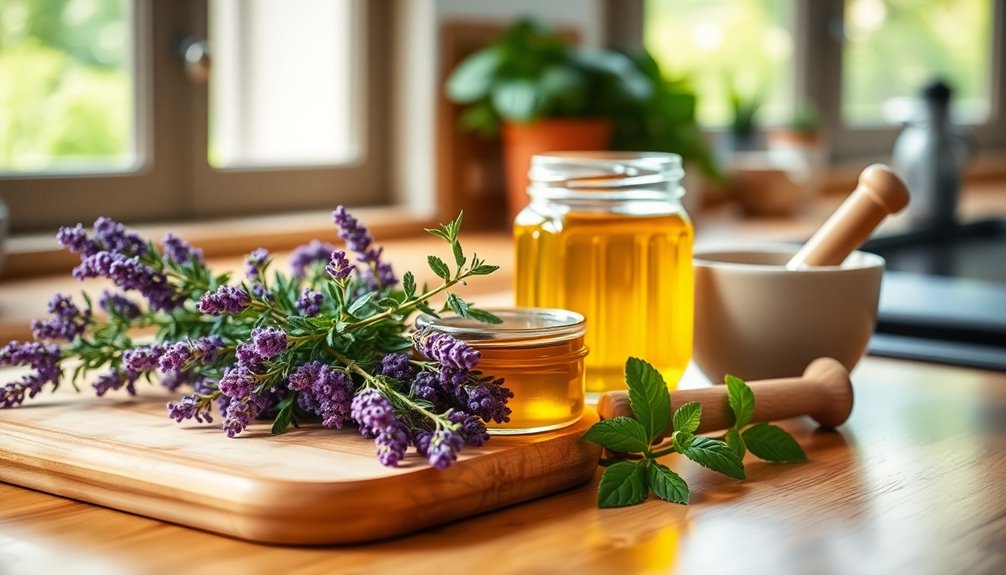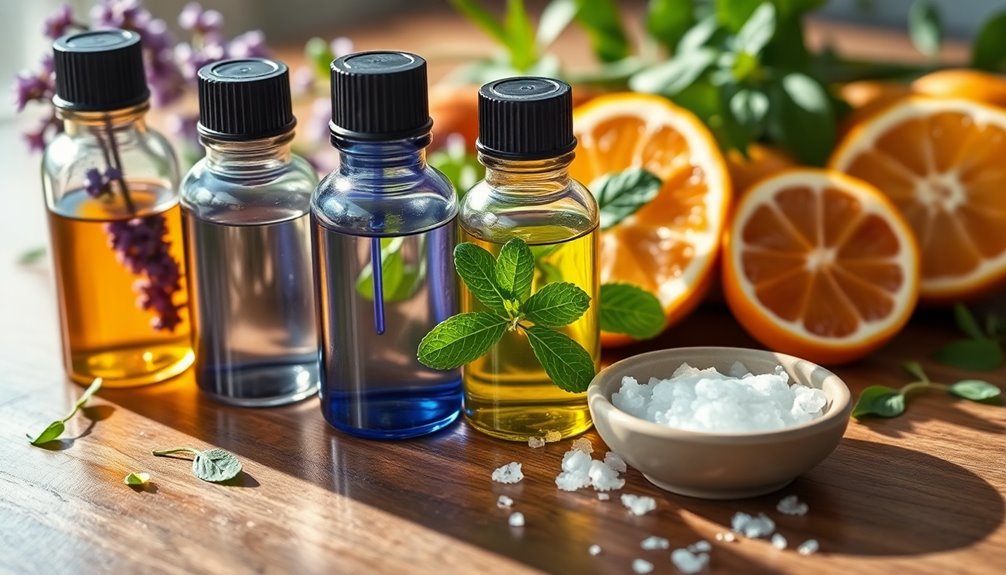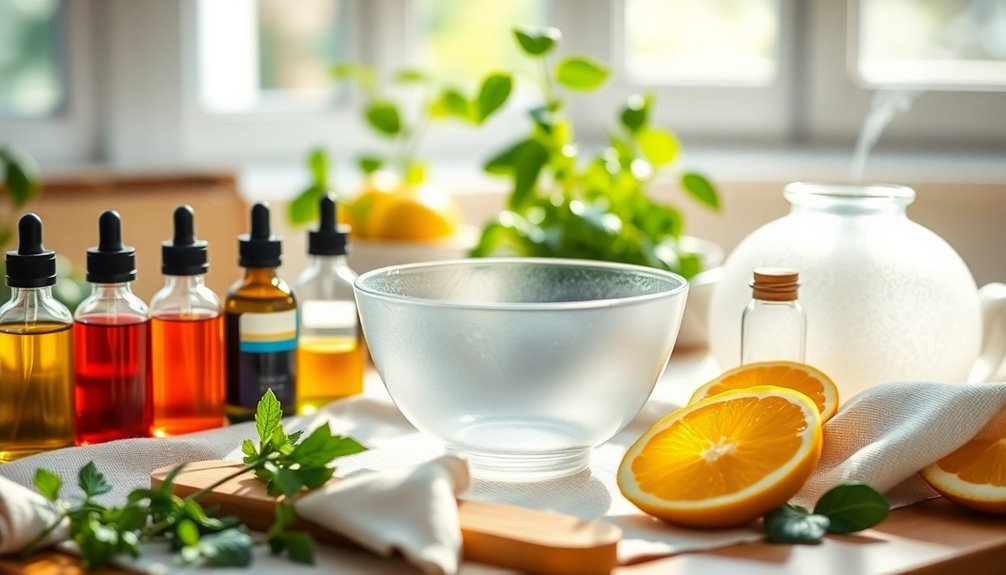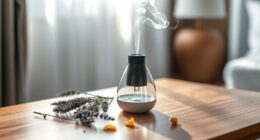Making infused oil for aromatherapy is simple and rewarding. Start by choosing dried herbs like lavender or chamomile, and mix them with a carrier oil such as almond or jojoba at a ratio of 1 part herbs to 5 parts oil. You can use a solar infusion by placing the jar in sunlight for two weeks, or a cold infusion method for 2-6 weeks at room temperature. Once infused, store the oil in a dark glass container in a cool, dark place. With these steps, you're on your way to creating therapeutic oils that support your wellness. Discover more tips to elevate your creations!
Key Takeaways
- Choose dried herbs like lavender or chamomile and combine them with a suitable carrier oil, maintaining a 1:5 herb-to-oil ratio for effective infusion.
- Select an infusion method such as solar infusion, cold infusion, or heat infusion, depending on your preferred timeline and desired potency.
- Store your infused oil in a cool, dark place using dark glass containers to preserve quality and prevent spoilage.
- Regularly check for signs of spoilage, such as off odors or cloudiness, and discard any compromised oils immediately for safety.
- Incorporate your infused oils into aromatherapy practices, skincare routines, or homemade candles for a soothing and beneficial experience.
Understanding Infused Oils

When you explore infused oils, you'll discover a fascinating process where herbs steep in carrier oils, extracting their beneficial compounds.
Using dried herbs is ideal for infusion since they've lower moisture content, reducing spoilage risks. You can experiment with various carrier oils like olive oil, which offers unique healing properties, or jojoba oil and sweet almond oil, each enhancing your final product.
The typical herb-to-oil ratio for cold infusion is 1 part herbs to 5 parts oil.
Infused oils serve many purposes, from topical remedies for skin conditions to aromatic components in your DIY wellness products. Whether for aromatherapy or massage oils, these infused oils harness the powerful beneficial properties of nature, enriching your self-care routine. Additionally, utilizing carrier oils ensures safe dilution of essential oils while maximizing their therapeutic effects.
Selecting Herbs and Oils

Choosing the right herbs and oils is vital for creating effective infused oils. Opt for aromatic plants like lavender, rosemary, and chamomile for their calming benefits. Olive oil is perfect as a carrier oil, thanks to its skin absorption and nutrient richness. Using dried herbs is important, as they reduce spoilage risks during the infusion process. Incorporating essential oils such as eucalyptus oil can enhance the therapeutic properties of your infused oil.
Here's a quick reference table for your selections:
| Herbal Plant | Benefits | Oil Type |
|---|---|---|
| Lavender | Calming, soothing | Olive oil |
| Peppermint | Invigorating, revitalizing | Olive oil |
| Chamomile | Relaxing, anti-inflammatory | Olive oil |
Ensure an effective infusion by following the herb-to-oil ratio of 1 part dried herbs to 5 parts carrier oil for best DIY wellness.
Solar Infusion Techniques
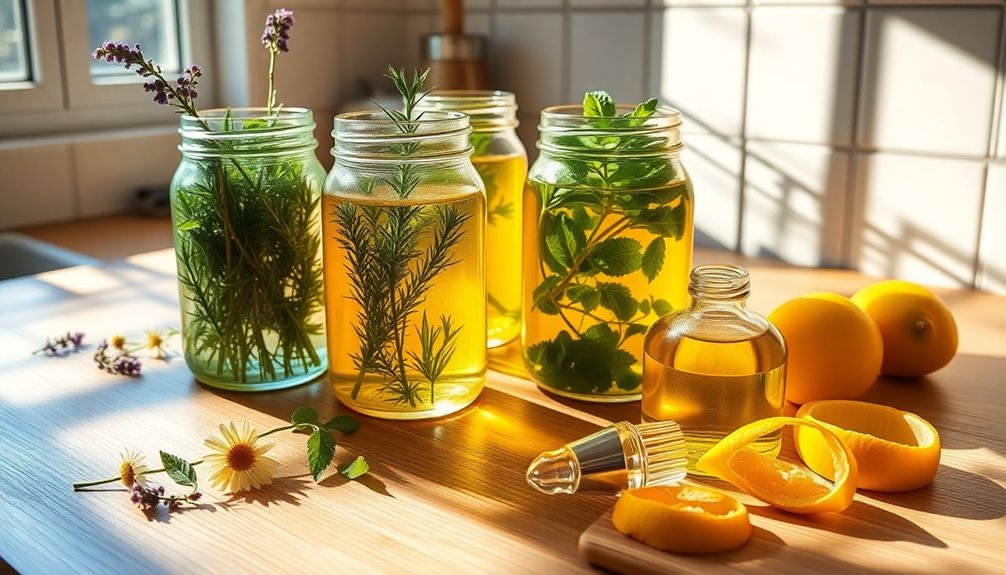
Solar infusion is a simple yet effective way to extract the benefits of herbs into oil using sunlight.
By following some key steps, you can create your own aromatic blends that harness the therapeutic properties of your chosen ingredients. Using essential oils like lavender oil can enhance the calming effects of your infusion.
Let's explore the benefits and the process for a successful infusion.
Benefits of Solar Infusion
Harnessing the power of sunlight not only enhances the extraction of beneficial compounds from herbs but also creates a natural and effective infusion method.
Solar infusion allows you to fill a glass jar with dried herbs and cover them with carrier oil, placing it in direct sunlight for at least two weeks. This process helps extract therapeutic properties, making your infused oils perfect for aromatherapy and enhancing your wellness routine.
Regularly shaking the jar guarantees an even distribution of beneficial plant compounds. However, spoilage monitoring is vital; discard any oils that show off odors or unusual discolorations. Additionally, using properly seasoned wood for heating can complement your eco-friendly lifestyle while creating a cozy atmosphere for your wellness practices.
With solar-infused oils, you gain versatile tools for skincare, culinary uses, and overall well-being.
Steps for Successful Infusion
When you want to create your own infused oils for aromatherapy, following the right steps guarantees a successful infusion.
Start by selecting fresh or dried aromatic herbs, ensuring they're clean and moisture-free. If using fresh herbs, let them wilt overnight to reduce water content.
Next, fill a glass jar with chopped fresh herbs or whole dried flowers, then cover them with a carrier oil, making sure the herbs are fully submerged. Seal the jar and place it in a sunny spot to extract beneficial compounds.
Allow the herbal oil infusion to steep for at least two weeks, shaking it gently every few days.
Finally, strain the oil into a clean, dark glass jar, and store in a dark place to maintain potency.
Alternative Infusion Methods
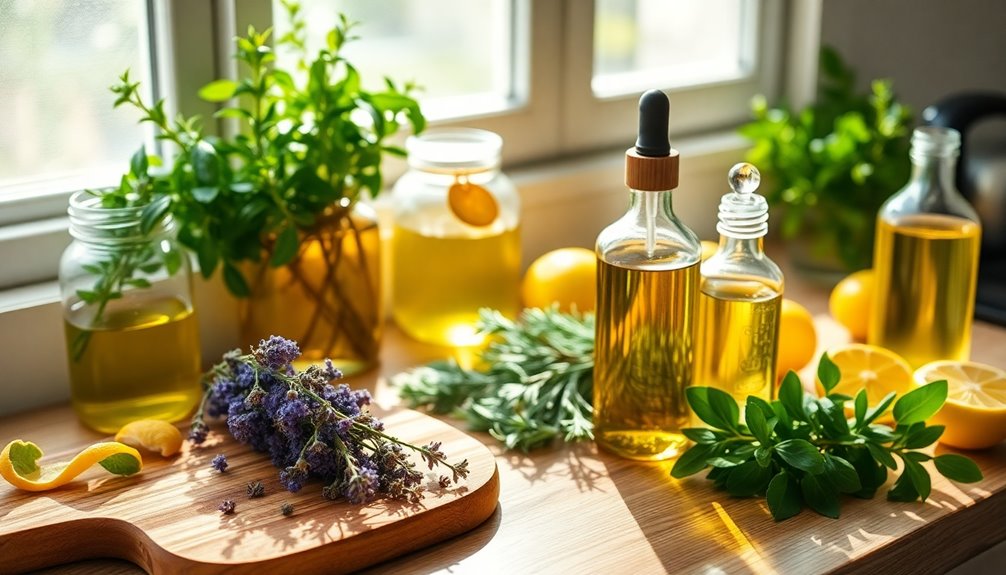
While many people are familiar with the traditional methods of infusing oils, alternative techniques can also yield rich, aromatic blends for your aromatherapy needs.
The cold infusion method allows you to steep dried plant material in a carrier oil at room temperature for 2-6 weeks, extracting therapeutic properties without heat.
The heat infusion method speeds things up, using gentle heat below 110°F for 30 minutes to several hours.
For a longer infusion, try the slow cooker method on low heat for 24 hours.
The double boiler method gently warms the oil for 3-4 hours, enhancing flavor.
Ultimately, the bain marie technique offers a controlled environment, keeping the infusion consistent without direct flames, perfect for creating your herb-infused oil. Additionally, using essential oils for aromatherapy can further enhance the therapeutic effects of your infused oils.
Storage and Shelf Life
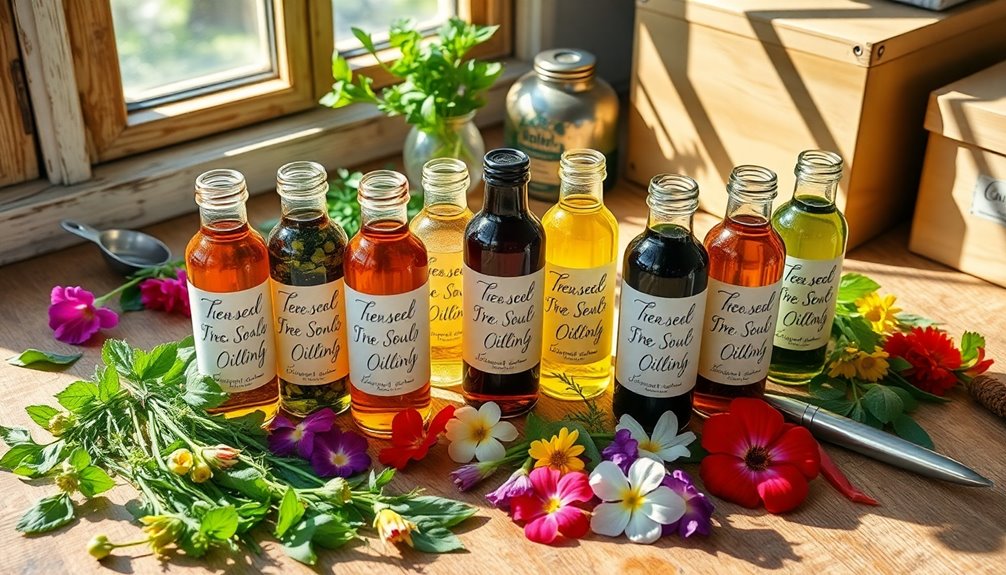
To keep your infused oils fresh, store them in a cool, dark place and use dark glass containers to protect them from light.
It's important to regularly check for any signs of spoilage, like mold or unusual odors.
Ideal Storage Conditions
Storing infused oils properly is vital for maintaining their potency and shelf life. Keep your oils in dark glass jars to protect them from light degradation, which can diminish their therapeutic properties.
A cool, dark place is ideal for storage, away from heat sources and moisture. Most infused oils, made with dried herbs, can last about a year if stored properly, while stable oils like jojoba can last over five years. Regularly checking for signs of spoilage is essential to ensure the quality of your oils.
It's important to monitor your infused oils regularly for signs of spoilage, such as visible mold, off odors, or cloudiness. If you notice any of these indicators, dispose of the oil immediately to guarantee your wellness practices remain safe and effective.
Container Types Matter
Choosing the right container for your infused oils is essential for preserving their quality and effectiveness.
Glass containers, especially dark ones, protect your oils from light degradation, ensuring they retain their beneficial properties longer. To prevent spoilage, always use airtight containers that minimize oxidation and moisture exposure.
Store your infused oils in a cool, dry place away from direct sunlight to maximize their shelf life, typically around a year when made with dried herbs.
Properly strained infused oils will be more resilient when stored correctly, enhancing their efficacy in aromatherapy applications. Additionally, using containers that are energy-efficient can further support your commitment to eco-friendly practices.
Recognizing Spoilage Signs
How can you tell if your infused oils have gone bad? Keep an eye out for spoilage signs like visible mold, off odors, or cloudiness.
These indicators suggest that harmful bacteria or mold may be present, compromising safety. Fresh herbs have a higher moisture content, making them riskier for spoilage, so check your oils regularly.
Proper storage in dark glass jars can help extend shelf life, but even then, you should remain vigilant. If you notice any unusual changes in color or consistency, it's best to discard the oil. Additionally, regular maintenance of your infused oils will help ensure they remain safe and effective for aromatherapy.
Storing infused oils safely and monitoring them closely will help you enjoy their benefits without worry!
Applications of Infused Oils
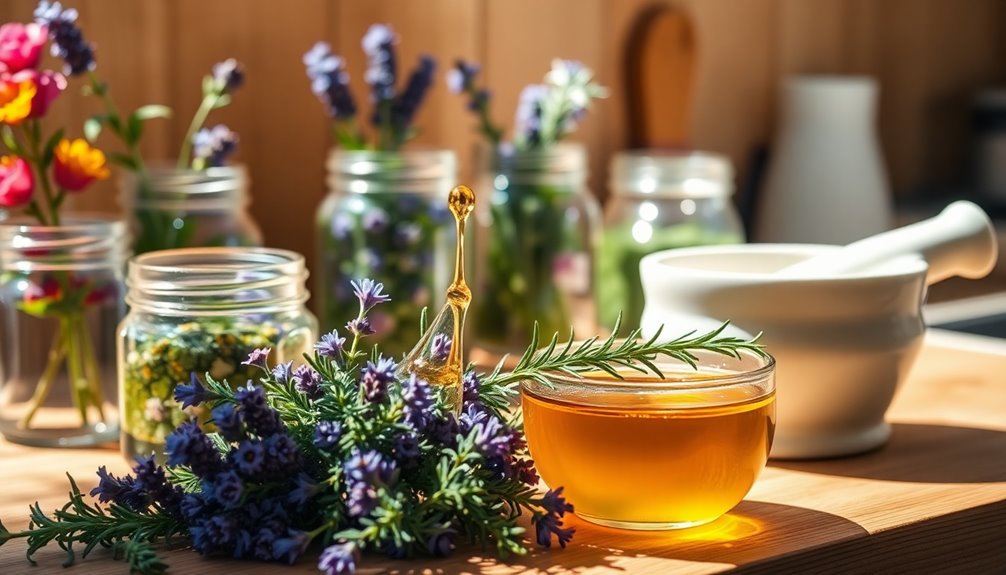
Infused oils offer a versatile range of applications that can elevate your aromatherapy experience. You can blend these oils with carrier oils to create massage oils, enhancing relaxation and well-being during your sessions.
Using aromatic plants like lavender and peppermint, infused oils provide soothing scents that alleviate stress and promote a calm environment. They also serve as natural ingredients in homemade candles, releasing delightful aromas into the air.
Additionally, infused oils make excellent bases for skincare products like facial oils and lotions, delivering fragrance along with the healing properties of the herbs to your skin. Incorporating them into bath products can further enhance your bathing experience, offering both therapeutic benefits and aromatic enjoyment for ultimate relaxation. Furthermore, regular use of essential oils can create a positive environment, reducing stress and enhancing emotional well-being.
Safety Considerations and Tips

While creating your own infused oils can be a rewarding process, it's essential to prioritize safety to guarantee a high-quality product.
To make sure that your oils remain safe and effective, follow these tips:
- Use dried herbs for oil infusions to minimize moisture content and the risk of spoilage.
- Always use clean glass jars and sanitize all equipment to prevent contamination.
- Regularly monitor infused oils for signs of spoilage, like off odors, cloudiness, or visible mold.
- Consider adding natural preservatives, such as vitamin E or antimicrobial essential oils, to extend shelf life.
Frequently Asked Questions
How Do I Make My Own Infused Oil?
To make your own infused oil, start by choosing dried herbs you love, like lavender or rosemary.
Fill a clean glass jar with the herbs, covering them with a carrier oil such as olive or jojoba.
Seal the jar and place it in a sunny spot for 2-6 weeks, shaking it gently every few days.
After the infusion, strain the oil into a clean container and store it in a cool, dark place.
Enjoy!
What Is the Best Oil to Use for Infusing?
When you're thinking about the best oil to use for infusing, consider your needs.
Olive oil's got great skin absorption, while jojoba oil mimics your skin's natural oils, making it perfect for facial applications.
Sweet almond oil's light and moisturizing, ideal for massage blends.
Coconut oil offers a nice scent, but its consistency can change with heat.
Grapeseed oil is pricier but packs a punch with antioxidants, enhancing your infusions.
Choose wisely!
How Do You Infuse Essential Oils?
To infuse essential oils, start by choosing a carrier oil like olive or jojoba.
Fill a jar two-thirds with the oil and add dried herbs or flowers.
For a slow infusion, place the jar in a sunny spot for 2-6 weeks, shaking it daily.
Alternatively, you can heat it gently in a double boiler for 30 minutes to a few hours.
Finally, strain the oil and store it in a dark glass bottle.
How Long Does Homemade Infused Oil Last?
Homemade infused oil typically lasts about a year when you use dried herbs and store it properly in a cool, dark spot.
If you choose a stable oil like jojoba, it can last over five years.
Keep an eye out for signs of spoilage, such as mold, off odors, or cloudiness, which means it's time to discard the oil.
Fresh herb-infused oils should be used within a few months due to their moisture content.
Conclusion
Now that you know how to make infused oils, it's time to release your inner herbalist! With a dash of creativity and a sprinkle of patience, you can craft your own wellness elixirs. Remember, just like a good mixtape, it's all about finding the right blend of herbs and oils that resonate with you. So, get your hands a little messy and enjoy the delightful aromas that will soon fill your space! Happy infusing!

